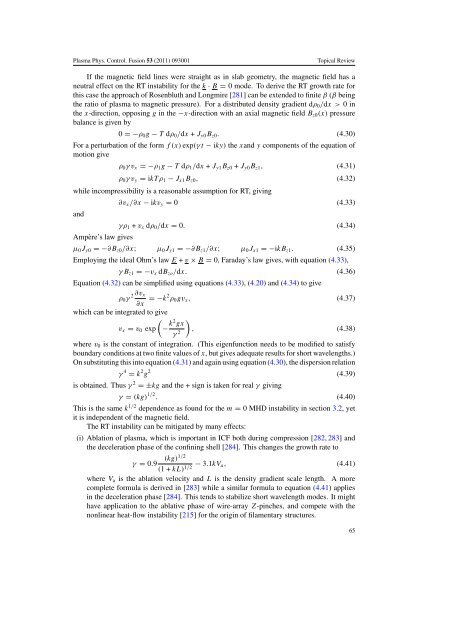Create successful ePaper yourself
Turn your PDF publications into a flip-book with our unique Google optimized e-Paper software.
Plasma Phys. Control. Fusion 53 (2011) 093001<br />
Topical Review<br />
If <strong>the</strong> magnetic field lines were straight as in slab geometry, <strong>the</strong> magnetic field has a<br />
neutral effect on <strong>the</strong> RT instability for <strong>the</strong> k · B = 0 mode. To derive <strong>the</strong> RT growth rate for<br />
this case <strong>the</strong> approach <strong>of</strong> Rosenbluth and Longmire [281] can be extended to finite β (β being<br />
<strong>the</strong> ratio <strong>of</strong> plasma to magnetic pressure). For a distributed density gradient dρ 0 /dx >0in<br />
<strong>the</strong> x-direction, opposing g in <strong>the</strong> −x-direction with an axial magnetic field B z0 (x) pressure<br />
balance is given by<br />
0 =−ρ 0 g − T dρ 0 /dx + J y0 B z0 . (4.30)<br />
For a perturbation <strong>of</strong> <strong>the</strong> form f(x)exp(γ t − iky) <strong>the</strong> xand y components <strong>of</strong> <strong>the</strong> equation <strong>of</strong><br />
motion give<br />
ρ 0 γv x =−ρ 1 g − T dρ 1 /dx + J y1 B z0 + J y0 B z1 , (4.31)<br />
ρ 0 γv y = ikTρ 1 − J x1 B z0 , (4.32)<br />
while incompressibility is a reasonable assumption for RT, giving<br />
∂v x /∂x − ikv y = 0 (4.33)<br />
and<br />
γρ 1 + v x dρ 0 /dx = 0. (4.34)<br />
Ampère’s law gives<br />
µ 0 J y0 =−∂B z0 /∂x; µ 0 J y1 =−∂B z1 /∂x; µ 0 J x1 =−ikB z1 . (4.35)<br />
Employing <strong>the</strong> ideal Ohm’s law E + v × B = 0, Faraday’s law gives, with equation (4.33),<br />
γB z1 =−v x dB zo /dx. (4.36)<br />
Equation (4.32) can be simplified using equations (4.33), (4.20) and (4.34) togive<br />
ρ 0 γ 2 ∂v x<br />
∂x =−k2 ρ 0 gv x , (4.37)<br />
which can be integrated to give<br />
( )<br />
v x = v 0 exp − k2 gx<br />
, (4.38)<br />
γ 2<br />
where v 0 is <strong>the</strong> constant <strong>of</strong> integration. (This eigenfunction needs to be modified to satisfy<br />
boundary conditions at two finite values <strong>of</strong> x, but gives adequate results for short wavelengths.)<br />
On substituting this into equation (4.31) and again using equation (4.30), <strong>the</strong> dispersion relation<br />
γ 4 = k 2 g 2 (4.39)<br />
is obtained. Thus γ 2 =±kg and <strong>the</strong> + sign is taken for real γ giving<br />
γ = (kg) 1/2 . (4.40)<br />
This is <strong>the</strong> same k 1/2 dependence as found for <strong>the</strong> m = 0 MHD instability in section 3.2, yet<br />
it is independent <strong>of</strong> <strong>the</strong> magnetic field.<br />
The RT instability can be mitigated by many effects:<br />
(i) Ablation <strong>of</strong> plasma, which is important in ICF both during compression [282, 283] and<br />
<strong>the</strong> deceleration phase <strong>of</strong> <strong>the</strong> confining shell [284]. This changes <strong>the</strong> growth rate to<br />
γ = 0.9<br />
(kg)1/2<br />
(1+kL) − 3.1kV a, (4.41)<br />
1/2<br />
where V a is <strong>the</strong> ablation velocity and L is <strong>the</strong> density gradient scale length. A more<br />
complete formula is derived in [283] while a similar formula to equation (4.41) applies<br />
in <strong>the</strong> deceleration phase [284]. This tends to stabilize short wavelength modes. It might<br />
have application to <strong>the</strong> ablative phase <strong>of</strong> wire-array Z-<strong>pinch</strong>es, and compete with <strong>the</strong><br />
nonlinear heat-flow instability [215] for <strong>the</strong> origin <strong>of</strong> filamentary structures.<br />
65














